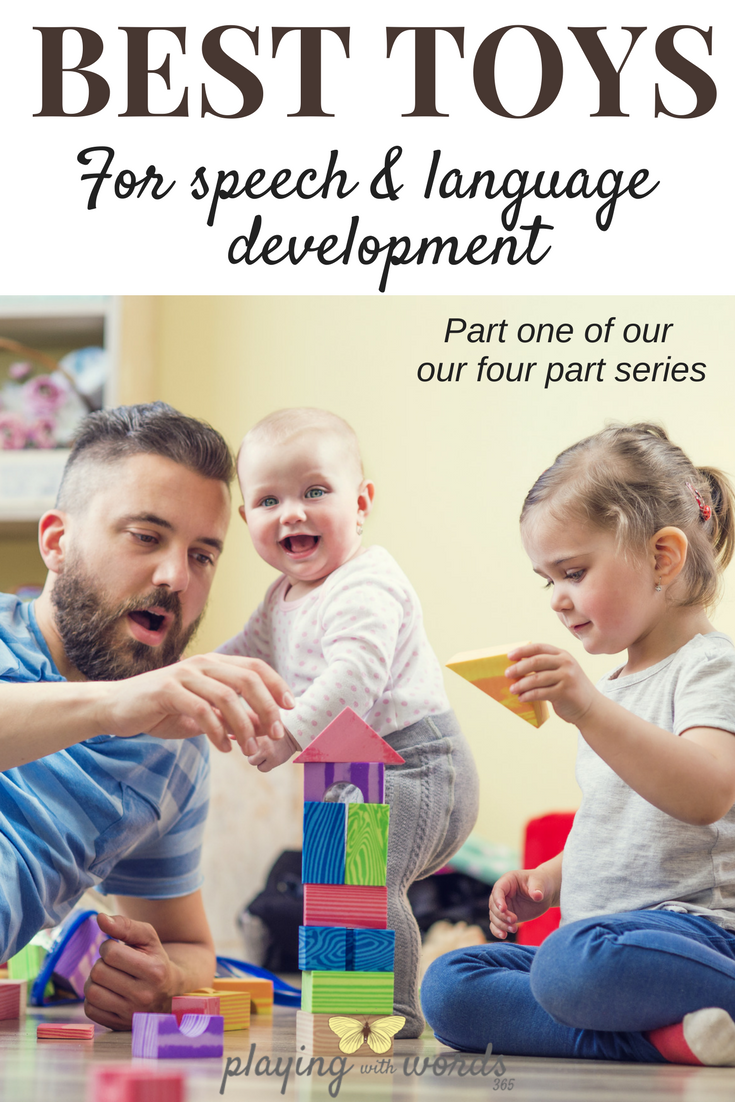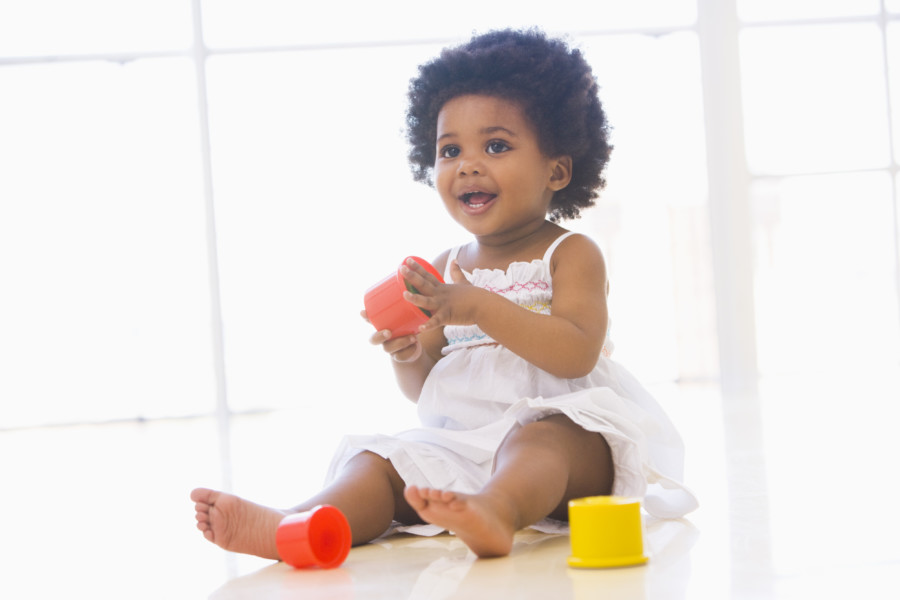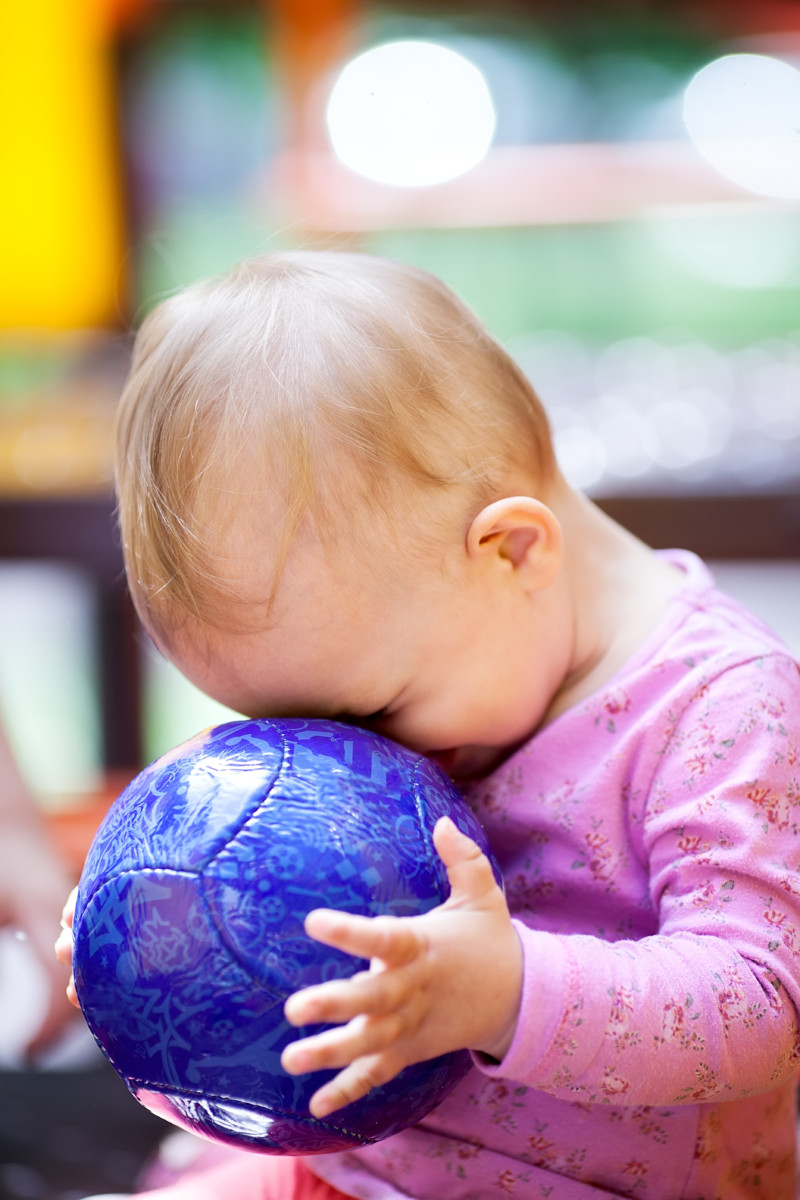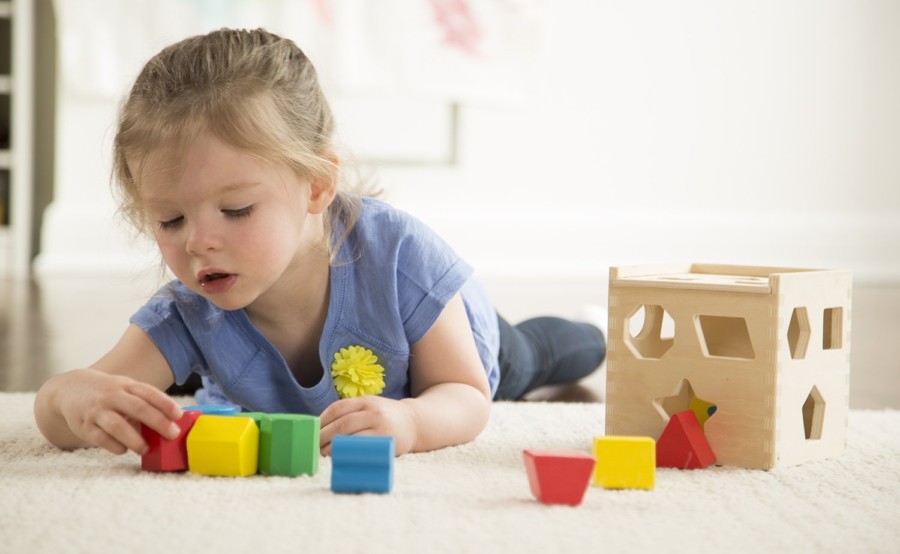I have been working with children in a professional capacity for nearly 20 years and have had the pleasure of working with children of all abilities in a wide variety of settings (preschools, elementary schools, middle and high schools, child care programs, recreation programs, homes, etc.) My professional experience paired with my role as a mother to four have given me a unique perspective on the use of toys as learning tools. Particularly how toys can help (or even HINDER!) the development of speech and language skills.
In the next few posts, Â I am going to share with you my personal top picks for toys for infants, toddlers and preschoolers and some of the specific skill areas that can be targeted and developed with these toys. However, it is important to know that for these toys to help support speech and language development you, as the parent or caregiver must help to facilitate that language.Â
Sit with your child. Remove distractions (like cell phones). Interact and communicate using some of the tips in the posts below:
Parallel Talk, Self Talk, & Descriptions
Expansions, Extensions, and Repetitions
Commenting and Asking Questions
Slow down- and enjoy this time with your child. If you are a fellow speech pathologist and work with infants, toddlers or preschoolers, you may also find this series of posts valuable for choosing and using therapy materials.
There are affiliate links in this post for your convince.Â

Stacking/Nesting Toys
Stacking/nesting toys are by far one of my most favorite toys for infants and toddlers. I have personally found that our stacking/nesting cups have been the most used and longest used toys that we have ever bought. They can help with the development of the following:
- Preposition concepts of in/out as he nests the different sized cups
- Preposition concepts of on, under, next to, in front, behind, top, bottom, on, off, and between as he stacks and builds with them.
- Color concepts
- Shape concepts (especially if you have different sets of cups in different shapes)
- Size concepts of big, bigger, biggest; small, smaller, smallest; small, medium, large
- Concepts of full/empty (by filling some cups up with other things like rice, beans, etc)
- Counting skills
- Problem solving skills: Figuring out which cups stack on others best, or nest within other best.
- Fine motor and motor planning skills
- Cause and effect relationships
- If the stacking/nesting cups have pictures of animals/letters on them you can also teach these vocabulary words.
- Other activity idea: Take another small toy (like an animal) and hiding it under a cup and have your infant or toddler find where the toy went.
- Other activity idea: If you are using plain plastic colored cups, you can draw or tape pictures of any target vocabulary on the cups and use the cups to target this vocabulary (i.e. You can play following directions games with the cups by saying “Put the horse cup on top of the pig cup.”)
My favorite set of cups can be found HERE on amazon.

Wooden Blocks
Every child should have access to blocks! I prefer a simple set of plain or colored blocks of different shapes and sizes, however I also love the square blocks with the letters/numbers on them as they provide the opportunity to expose children to letters and numbers (and later on when they are older these blocks can be a fun way to work on letter/number recognition and even some word recognition or spelling practice!). Alternatively you can start out with a good set of foam blocks if you have a thrower ;). Â Blocks can help support the development of the following:
- Preposition concepts of on, under, next to, in front, behind, top, bottom, on, off, and between as he stacks and builds with them.
- Color concepts
- Shape concepts
- Letter and Number concepts (if you are using blocks with letters/numbers)
- Size concepts
- Counting skills
- Problem solving skills: i.e. How to create a stable tower that won’t fall down
- Hand-eye coordination/Fine motor skills and visual processing
- Cause and effect relationships
- When at school or in a play situation, children can practice their sharing, cooperation, problem solving skills and more while building with their friends.
- Math and science principals like gravity and balance (not my expertise! Ha!)
I like Melissa & Doug blocks. They have a colored set, a plain set, and an ABC set. I actually found all of ours at Homegoods! If you are looking for a foam set, Amazon sells THIS one which gets good reviews.
Balls, Balls and More Balls
All of my children have LOVED balls as toddlers. In fact my youngest, currently 17 months, is obsessed with balls and throwing them all over the house. Balls can help teach so many concepts such as:
- Concepts of in, on, off, through, up, down, next to, in front, behind, top, bottom (while using the balls in different activities and with other items like basketball hoops, baskets, tunnels, cups, boxes, etc.)
- Color concepts (using different colored balls)
- Size concepts like big, medium, small, biggest, smallest, etc (using different sized balls)
- Tactile concepts/vocabulary like hard, soft, bumpy, smooth, etc. (when using balls made of various materials).
- Counting concepts
- Problem solving skills (i.e. which balls can fit in which containers?)
- Gross motor, motor planning, and hand/eye skills while throwing, catching, and rolling
- Social skills: Believe it or not, the simple act of rolling a ball back and forth to another person takes quite a bit of social skills! In order to roll ball back and forth, you need to 1) Watch your friend 2) Read your friend’s non verbal language indicating whether or not he is ready to “catch” the ball (facial expressions, body position, gestures) 3) Roll the ball 4) Wait patiently for your turn to catch 5) Read your friend’s non verbal cues that he is ready to roll the ball to you 6) Catch the ball.
Balls can be found pretty much anywhere they sell toys. I like having a set like THIS one around that provide different sensory experiences. Another fun alternative is setting up a small ball pit– we used to have one when my oldest two were young and it provided hours and hours of play!

Shape Sorter
Shape sorters can teach many of the same concepts and skills that blocks can, with some added bonuses:
- Shape concepts (Obviously, right? Ha!)
- Preposition concepts of in, out, through.
- Color concepts
- Concepts of full and empty (full of shapes after all the shapes have been put in).
- Fine motor and motor planning skills
- Counting skills
- Problem solving skills
My favorite is from Melissa and Doug. All 4 of my kids have loved it (pictures below).

Toy Phone
Toy phones are by FAR one of my favorite toys. They are low cost and grow with your child. And think about it…what is it that we do on the phone? WE TALK! (Well we used to talk on them, right?!) We use LANGUAGE! So a toy phone is a GREAT toy that can be used to support speech and language development such as:
- Social skills/pretend play: Your child can use the play phone to “practice” her speech and language skills and “talk” to an array of different “people.” 😉 Grab yourself another play phone, and have a conversation with him!
- Social skills/turn taking: Many times, your child will talk on the phone, and then will want YOU to talk on it. This is a great foundation for turn taking!
- Speech/Language practice: I have had some clients who have not been, lets say, “in the mood” to participate in speech and language activities either with me or with their parents (like when doing homework). However some kids will do the activities if we are doing them in the phone! It’s funny what will motivate a kid! 😉
One problem when looking for toy phones these days is that most come with batteries and make lots of noise and have have flashy lights. I don’t recommend these unless you can remove the batteries. My favorite toy phone is honestly the old school Fisher Price Chatter phone.
This is the first in a series of four on toys to support speech & language development. They were originally published in February of 2012 and were updated and reposted in March of 2018. Additional posts in this series will be linked here as they are updated and reposted.Â
Thanks for all the great and amazing information!
Hi. I was surprised to find this website, but thought it was quite cool (wrote something similar –years ago). Anyway, to add–There is always– Put __________ on the couch. I know that you address prepositions and haven’t read all of your ideas.
One more. Once my little ones began to say, “more”. I then had them go to “I want more”. This is especially good more a good-bye hug. “I want up.”
Due to health reason, I had to stop DT. However, I am giving your site a plug on Pinterest.
God Bless!!
This is a great article. I however can’t seem to find links to parts 2,3, and 4 on this page. It would be really nice if it could be edited to add those. I’ll see if I can find the others through site search.
I thought the same thing but if you got to toy recommendations it is on that page 🙂
my grand daughter is 16 and diagnosed with MR or mentally retarded and functioning as 12 or 13. She attends LRE classes in a special section of the high school. She has not mastered reading or making complete sentencing. I do not have custody, however, I have been allowed to enroll her in a facility for two to three hours of music learning lab. She enjoys going and doing her activitis on the computer,but, I want her to read so badly;yet, we can’t seem to unlock the door to that area of her brain. She is high functioning, but, it seems she has a retention deficeit that prevents her from getting serious about reading. I need your help badly.
Thanks
Hi Jessica,
You may want to visit the Institute for Achievement of Human Potential (IAHP) website or Facebook page. I have used their reading program (originally designed for children with under developed brain power) with my daughter and she was reading words since 1yr 1month and now at 3 is reading at grade 2 or 3 level. It involves pattern recognition starting with single words and gradually moving to phrases and books. I recommend it based on the results I have experienced first hand with my daughter.
I hope this helps in some way with your grand daughter.
So true that the classic toys are not only the best for playing but for helping kids develop.
Really useful info – thank you. I was wondering how I could get involved with my baby’s learning and play when he gets older. There are loads of ideas here for us to try!
Hello Katie,
I love these posts! I am in my undergrad school work majoring in speech pathology and I would love to start gradually getting toys for when I start working! Obviously some are too large for some therapy areas but what would be toys you would definitely recommend?
Thanks,
Abigail
Any tips for 4yo non-verbal twins with autism who love computers and tablets?
This is such a great list! We have all of these except the nesting blocks, which I really need to invest in! I was dismayed when our daughter received not one, but TWO play phones for Christmas last year. I never thought about the opportunities for learning with them that you listed. Thanks!
Alicia Owen recently posted..Dark Eden Book Review
Wonderful ideas, but I wish you would replace the toy phone idea. I think exposing (encouraging) the use of cell phones to young children, which might be the next step from toy phones, is not in their best interest. Thank you…
Hi there and thanks so much for your thoughts. No where in my post was I encouraging the use of a cell phone. I was encouraging the use of a *play phone* because talking on the phone is a common, social act and provides many opportunities for language use. 🙂
Great Ideas & Great Posts …!!
I have a toddler with language delay and was puzzled where to start with but now I have got
some wonderful ideas.
Thank you very much Katie .
Hi Katie,
my son is being raised multilingual. Does the same prinicpal apply to his speech? He is now 21 months and only knows about ten words e.g. instead of saying car he will say brum brum. Your feedback will be appreciated as I am a very confused mum at the moment.
Sounds good. Thanks for the suggestions. Will follow up.
hi katie these are very helpful ways for kids. i want to ask my girl is speeh delay. how can i encourage her to speak . she babbles and speaks a whole sentence smtime but she dont means what she speaks . like she dont say to me MAMA or ask for milkor any snack.just bring her snack box or her milkbottle to me when hungry or bring her diaper but no meaningfull words or speech. please help me with sm helpfull info ., any articles any helfull stuff that i can apply for her. thank you
I am an SLP. Do mind if I share this blog with my parents?
Yes you may!
Sharing good information is a great help to a parents. 🙂
LOVE your web site. THANK YOUUUUUUU!!!!
This site just made me feel so much better. My kiddo just went for his 18 month appt and they seemed concerned he wasn’t saying 20 words. He says mama, dada, ball, bus, Mal (our dog), no, Un, deux, trois (we are bilingual and he says his numbers in French), Ba (for sheep) he also knows objects very well and can find his hockey sticks in a heartbeat if you ask him. I was just so upset that they seemed so concerned about word count and not how well he seems to be developing as a whole. I’m really glad I found this site, thanks so much.
Heather Hotte